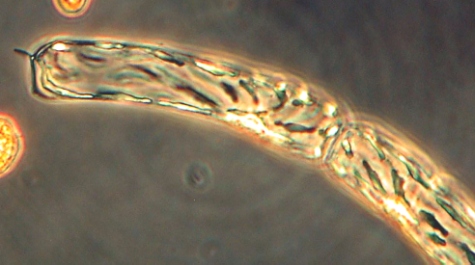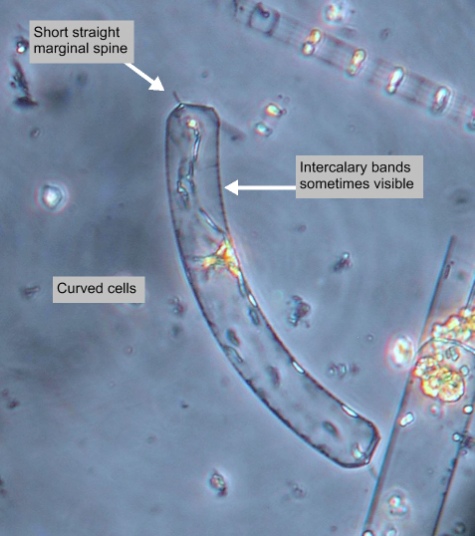

|
Synonym(s)
Heterotypic
A difference in type. In naming species, a heterotypic synonym is one that comes into being when a taxon becomes part of a different taxon. Compare to homotypic.
(heterotypic)Eucampia striata Stolterfoth 1879 Close
Basionym
The original name for an organism. In botany, the original published nomenclature from which a new binomial nomenclature is derived for a particular group of organisms (Tindall 1999).
(basionym, CloseHomotypic
Expressing the same fundamental type or structure; may or may not be symmetrical (e.g., the two valves of a diatom, where they are the same shape and appearance, but one is bigger than the other). In naming species, a homotypic synonym is one that comes into being when a taxon gets a new name (without being added to an already existing taxon).
homotypic)(Guiry and Guiry 2011)
Classification
(Guiry 2011)
Lifestyle
Description
Valve
In diatoms, the structurally distinct halves of the cell wall (Becker 1996).
Valves are flat with rounded edges. Cells have a strong spine on the valve CloseMargin
The outline or border that defines the shape of an organism or cell.
margin, which fits into a depression on the neighbouring cell. Chloroplasts are numerous, small, and oval-shaped. CloseNucleus
(plural: nuclei) In eukaryotic cells, a membrane-bound organelle that contains the cell's genetic information; the nucleus controls the activities of the cell by controlling gene expression.
Nucleus is located near the cell wall (Cupp 1943). Cells are yellow-brown in color (Guiry 2011).Intercalary bands
Girdle bands that are furthest away from the valve (Smithsonian 2011).
Intercalary bands are collar-like and numerous. CloseImbrication lines
In dinoflagellates, the overlapping arrangement between adjacent thecal plates (Tomas 1997).
Imbrication lines are sometimes visible. Cell wall is weakly CloseSiliceous
Describing the character (i.e., white, shimmery) or chemical presence silicon dioxide (SiO2) as a component of phytoplankton cell covering.
siliceous with no distinct structures (Cupp 1943).Measurements
Pervalvar axis
The axis through the centre point of the two valves of a frustule. This axis is perpendicular to the valve face.
(pervalvar axis): 30 - 300 μmDiameter: 6 - 50 μm
(Hasle and Syvertsen 1997, Kraberg et al. 2010)
Similar species
Harmful effects
Habitat
Distribution
Cosmopolitan except in polar regions (Hasle and Syvertsen 1997).
Present mainly in summer and fall in Northern European seas (Kraberg et al. 2010).
Very widespread and often abundant (Cupp 1943).
Growth conditions
Environmental Ranges
Temperature range (°C): 3.924 - 29.468
Nitrate (μmol L-1): 0.053 - 20.029
Salinity: 30.119 - 38.049
Oxygen (mL L-1): 4.444 - 7.715
Phosphate (μmol L-1): 0.046 - 1.656
Close
Silicic acid
A general term to describe chemical compounds containing silicon, oxygen and hydrogen with a general formula of [SiOx(OH)4-2x]n. Diatoms polymerize silicic acid into biogenic silica to form their frustules (Azam and Chisholm 1976).
Silicate (μmol L-1): 0.648 - 35.557(OBIS 2011, cited in EOL 2011)
Bloom characteristics
References
Cupp, E. E. 1943. Marine Plankton Diatoms of the West Coast of North America. University of California Press. Berkeley, California. 238.
Del Amo, Y., Le Pape, O., Tréguer, P., Quéguiner, P., Ménesguen, A. and Aminot, A. 1997a. Impacts of high-nitrate freshwater inputs on macrotidal ecosystems. I. Seasonal evolution of nutrient limitation for the diatom-dominated phytoplankton in the Bay of Brest (France). Marine Ecology Progress Series. 161: 213-224.
Del Amo, Y., Quéguiner, B., Tréguer, P., Breton, H. and Lampert, L. 1997b. Impacts of high-nitrate freshwater inputs on macrotidal ecosystems. II. Specific role of the silicic acid pump in the year-round dominance of diatoms in the Bay of Brest (France). Marine Ecology Progress Series. 161: 225-237.
Encyclopedia of Life (EOL). Guinardia striata (Stolterfoth) G. R. Hasle. http://www.eol.org/pages/907115. Accessed 30 Jul 2011.
Guiry, M. D. 2011. Guinardia striata (Stolterfoth) Hasle, 1997. http://www.marinespecies.org/aphia.php?p=taxdetails&id=149113. Accessed 30 Jul 2011.
Guiry, M. D. and Guiry, G. M. 2011. Guinardia striata (Stolterfoth) Hasle. http://www.algaebase.org/search/species/detail/?species_id=43912. Accessed 30 Jul 2011.
Hasle, G. R. and Syvertsen, E. E. 1997. Marine diatoms. In: Tomas, C. R. (ed.) Identifying Marine Phytoplankton. Academic Press, Inc., San Diego. 5-385.
Il'yash, L. V., Matorin, D. N., Kol'tsova, T. I. and Sham, H. H. 2004. Spatial Distribution and Daily Dynamics of Phytoplankton in Nhatrang Bay of the South China Sea. Oceanology. 44(2): 219-229.
Kraberg, A., Baumann, M. and Durselen, C. D. 2010. Coastal Phytoplankton: Photo Guide for Northern European Seas. Verlag Dr. Friedrich Pfeil, Munchen, Germany. 204.
Ocean Biogeographic Information System (OBIS). Guinardia striata. http://www.iobis.org/mapper/?taxon_id=449120. Accessed 30 Jul 2011.
Rousseau, V., Leynaert, A., Daoud, N. and Lancelot, C. 2002. Diatom succession, silicification and availability in Belgian coastal waters (southern North Sea). Marine Ecology Progress Series. 236: 61-73.
Schapira, M., Vincent, D., Gentilhomme, V. and Seuront, L. 2008. Temporal patterns of phytoplankton assemblages, size spectra and diversity during the wane of a Phaeocystis globosa spring bloom in hydrologically contrasted coastal waters. Journal of the Marine Biological Association of the United Kingdom. 88(4): 649-662.
Shuter, B. J. 1978. Size dependence of phosphorus and nitrogen subsistence quotas in unicellular microorganisms. Limnology and Oceanography. 23(6): 1248-1255.
Sournia, A., Birrien, J.L., Douvillé, J. L., Klein, B. and Viollier, M. 1987. A daily study of diatom spring bloom at Roscoff (France) in 1985. I. The spring bloom within the annual cycle. Estuarine, Coastal and Shelf Science. 25: 355-367.
Wichard, T., Poulet, S. A., Boulesteix, A. L., Ledoux, J. B., Lebreton, B., Marchetti, J. and Pohnert, G. 2008. Influence of diatoms on copepod reproduction. II. Uncorrelated effects of diatom-derived α, β, γ, δ-unsaturated aldehydes and polyunsaturated fatty acids on Calanus helgolandicus in the field. Progress in Oceanography. 77(1): 30-44.
Widdicombe, C. E., Archer, S. D., Burkill, P. H. and Widdicombe, S. 2002. Diversity and structure of the microplankton community during a coccolithophore bloom in the stratified northern North Sea. Deep-Sea Research. Part II, Topical Studies in Oceanography. 49(15): 2887-2903.
